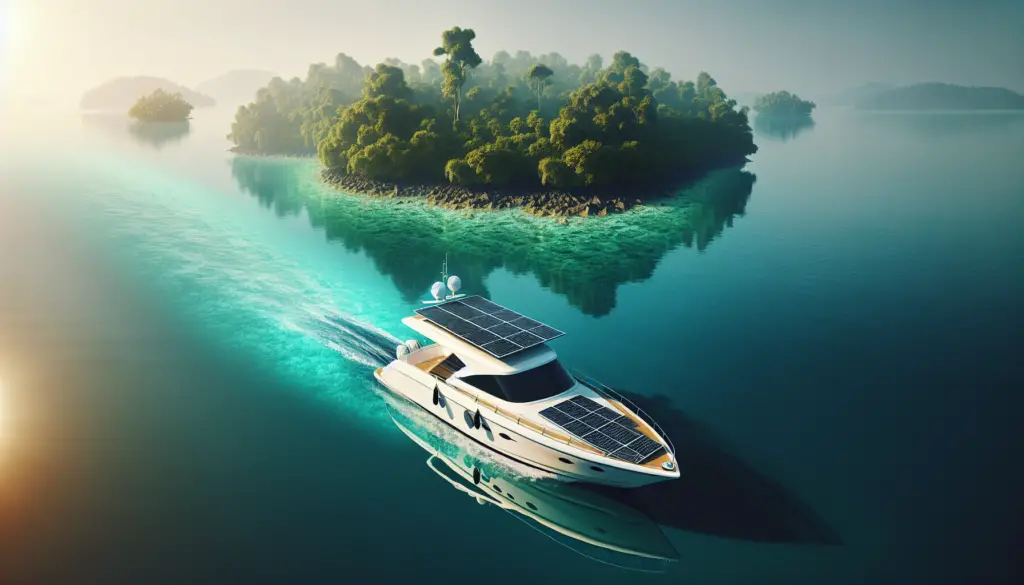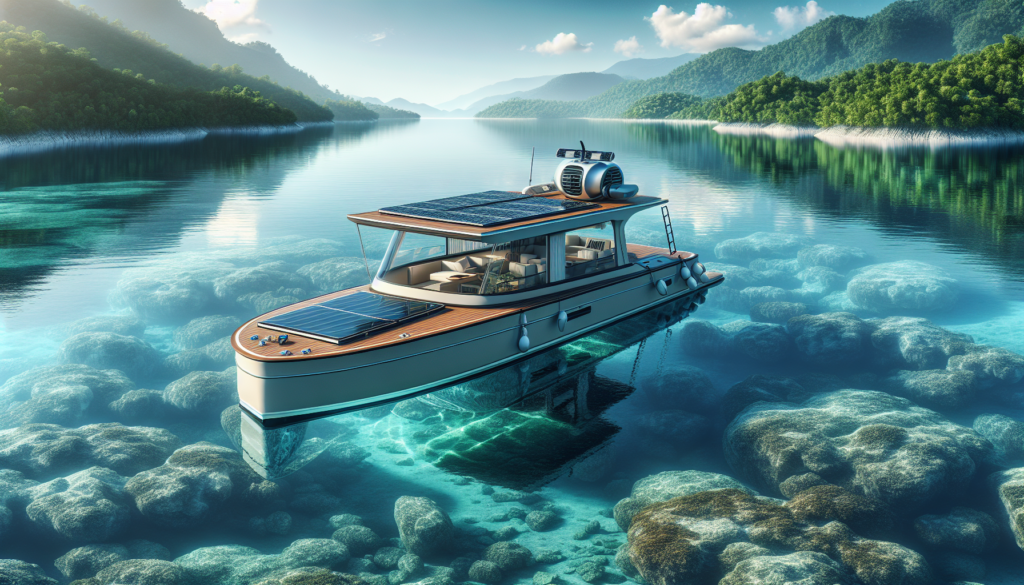You probably enjoy the freedom of the open water when you’re out boating, but have you ever considered the environmental impact? The reality is, boating can significantly contribute to your carbon footprint. But before you sell off your watercraft, rest assured, there are concrete steps you can take to minimize this impact. This article enlightens you on the most effective ways to cut back on your personal carbon emissions while boating without sacrificing the thrill of sea expeditions. From fuel efficiency to sustainable products, you’ll be surprised how effortlessly you can turn your boating adventures into a more eco-friendly pursuit.

Understanding the Carbon Footprint of Boating
When discussing environmental impacts, “carbon footprint” is a term you’ll often stumble upon. But have you ever stopped to think about what it might mean in terms of boating? The carbon footprint of boating refers to the total amount of greenhouse gases, including carbon dioxide, that are emitted into the atmosphere as a direct result of boating activities.
Definition of a boating carbon footprint
In layman terms, the boating carbon footprint is the total set of greenhouse gas emissions caused directly and indirectly by a boat, expressed as a CO2 equivalent. This includes the burning of fuel for propulsion, heating, or generation of electricity, as well as manufacturing and maintenance of the boat.
Factors contributing to boating carbon footprint
Several variables contribute to the boating carbon footprint. The primary factor is the type and amount of fuel consumed. Other factors include the manufacturing process of the boat, the materials used, and the means of disposal at the end of the boat’s life. Hours spent on water, boat size, and even your cruising speed all add up to your boating carbon footprint.
Impacts of boating on the environment
Boating has multiple impacts on the environment. In addition to releasing carbon dioxide and other greenhouse gases, boats can also spill oil and chemicals, which can harm aquatic life. Speed boating and large wakes can cause shoreline erosion and harm birds and other wildlife.
Switching to Green Propulsion Systems
If you want to reduce your boating carbon footprint, switching to a green propulsion system is a major step. There are a few options available, with the most common being hybrid, electric, and solar-powered propulsion systems.
Hybrid propulsion systems
As the name suggests, hybrid propulsion systems combine traditional combustion engines with electric power. These systems reduce emissions and increase fuel efficiency by alternating between the two power sources.
Electric propulsion systems
Electric propulsion systems replace combustion engines entirely with electric motors. These systems use electricity stored in batteries, which can be recharged from the grid or through onboard solar panels or wind turbines. Electric propulsion produces almost no emissions and is very efficient.
Solar-powered propulsion systems
Solar-powered propulsion systems combine solar panels and electric motors. They generate electricity directly from sunlight and store it in batteries. Like electric propulsion, they produce minimal emissions. However, solar-powered systems depend on sunlight and therefore require good weather and large numbers of solar panels.
Efficient Use of Fuel
Using your boat’s fuel efficiently is an excellent way to reduce your carbon footprint.
Adopting slow cruising speeds
The faster you go, the more fuel your boat consumes. So, by adopting slower cruising speeds, you can significantly reduce your boat’s fuel consumption.
Regular engine maintenance
A well-maintained engine runs more efficiently and uses less fuel. Regular engine maintenance should include changing the oil and filters as well as cleaning, adjusting, and repairing as needed.
Effective route planning
By planning your route efficiently, you can reduce the distance traveled and, therefore, fuel consumption. Use navigation aids, check weather conditions, and avoid challenging sea conditions to minimize resistance and increase fuel efficiency.

Utilizing Renewable Energy Sources
Renewable energy sources are becoming increasingly popular in boating. Solar panels, wind energy, and hydro-generators are all clean, sustainable ways to power your boat.
Installing solar panels
Solar panels convert sunlight into electricity. They can be installed on the roof or deck of your boat and used to charge batteries that power your boat’s systems.
Using wind energy
Wind generators convert wind energy into electricity. They work best on large boats that have plenty of space to accommodate the generator.
Benefiting from hydro-generators
Hydro-generators utilize the power of moving water to generate electricity. They are best suited for fast-moving boats, such as sailboats and catamarans.
Embracing Energy-Efficient Boat Design
Boat design significantly impacts energy efficiency. Lightweight materials, aerodynamic shapes, and insolation can all help reduce a boat’s energy consumption.
Lightweight materials
Lightweight materials reduce the weight of the boat, reducing the energy needed to move it. Common lightweight boat materials include composites such as fiberglass and carbon fiber.
Aerodynamic boat shapes
An aerodynamically designed boat reduces air and water resistance, making it move more efficiently through the water. This can significantly decrease fuel consumption.
Insulation for energy conservation
Insulation can help conserve energy by keeping heat in during the cooler months and out during the warmer months. Proper insulation reduces the need for heating and cooling, thereby saving energy.
Responsible Boat Manufacturing
The manufacturing process of a boat also contributes to its carbon footprint. Therefore, it’s essential to consider sustainable materials, waste reduction, and energy-efficient processes when manufacturing boats.
Use of sustainable materials
Sustainable materials include those that are recycled, renewable, or have a low environmental impact. For example, a wooden boat made from sustainably managed forests is more eco-friendly than one made from non-renewable resources like fiberglass.
Reducing waste in the manufacturing process
Reducing waste means using materials more efficiently and recycling waste products. This can also include reusing old boats and parts instead of being discarded.
Energy-efficient manufacturing processes
Energy-efficient manufacturing can reduce the carbon footprint of a boat significantly. This can involve everything from more efficient machinery and equipment to better building design and processes.
Recycling and Boat Disposal
Proper disposal of boat parts and recycling used boats is an important part of reducing the boating carbon footprint. Some boat manufacturers are even considering biodegradable boats.
Proper disposal of boat parts
Proper disposal means following legal and environmental guidelines for discarding boat parts. This could mean recycling or reusing parts, or disposing of them at a designated facility.
Recycling used boats
Recycling old boats helps reduce waste and can provide materials for new boats. Before recycling, boats should be stripped of any hazardous materials such as batteries and fuel tanks.
Consideration of biodegradable boats
Biodegradable boats are an innovative idea that’s currently being researched. These boats would be made from materials that decompose naturally, reducing waste and pollution.
Sustainable Boating Practices
Sustainable boating involves much more than just the boat itself. It should also include sustainable practices while on board.
Proper waste management onboard
This includes separating recyclables, composting organic material, and properly disposing of waste. Never toss waste overboard; always take it back to shore for proper disposal.
Reducing water usage
Conserve fresh water by using it sparingly and installing water-saving devices such as showerheads and faucets. Collect rainwater for non-potable uses like cleaning.
Responsible fishing practices
This means respecting bag limits, fishing seasons, and size restrictions. Always release undersized or overshot fish, and avoid harming or disturbing other marine life.
Educating Others on Reducing Boating Carbon Footprint
education and sharing knowledge about sustainable boating practices can help others reduce their boating carbon footprint.
Hosting informational sessions
You can host informational sessions or workshops on sustainable boating practices. These could include topics like green propulsion systems, fuel efficiency, and waste management.
Sharing sustainable boating tips
Share tips and best practices about sustainable boating with your friends, family, and fellow boaters. This could be through conversations, social media, or clubs and organizations.
Joining global boating-related environmental campaigns
Joining global campaigns can help spread awareness and draw attention to the issue of boating carbon footprints. They can also influence policy and regulation, which leads us to our final section.
Policy and Regulation for Lower Carbon Boating
Policies and regulations play a key role in reducing the carbon footprint of boating. Increasing awareness, compliance, and advocacy can have a significant impact.
Understanding existing policies
Understanding the existing policies related to boating and its environmental impact is the first step in compliance. This includes local, national, and international regulations.
Advocacy for stricter regulations
By advocating for stricter regulations, you can promote sustainable boating practices and reduce the carbon footprint of boating.
Compliance with environmental laws
Compliance is key to the success of environmental regulations. This means following the rules, reporting violations, and encouraging others to do the same.
In conclusion, reducing the carbon footprint of boating requires a concerted effort from everyone involved. From boat manufacturers and policymakers to the individual boater, we all play a role in supporting sustainable boating practices. While it might require some adjustments, the payoff is worth it — a healthier planet for us and for future generations.

